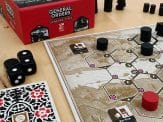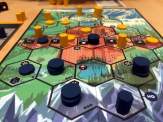| Release Date: 2025 | Players: 1-4 |
| Designer: Fabio Lopiano, Mandela Fernandez-Grandon | Length: 60-90 minutes |
| Artist: Ian O'Toole | Age: 14+ |
| Publisher: Osprey Games | Complexity: 3.0 / 5 |
| Plastic (by weight): 5% | Air (by volume): 30% |
From the mist of Lake Titicaca, eight children of Inti and Mama Quilla stepped onto the high plains, their feet brushing the grass and waking the land itself. As their journey continued, the mountains claimed some of them, caves swallowed others, until only one final pair held the golden rods. By then, they had taught the first clans who had accompanied them to weave, shape clay, carve terraces into the mountainside and coax life from reed and soil. These clans were the Ayar: Children of the Sun by Fabio Lopiano and Mandela Fernandez-Grandon from Osprey Games with art by Ian O’Toole.
Listen to the Audio Version
Intro Music: Bomber (Sting) by Riot (https://www.
Music: Beauty Of The Earth 3 – Grasslands, produced by Sascha Ende
Link: https://ende.
Music: Binaural Sleep Vol. 5, produced by Sascha Ende
Link: https://ende.
Sunlit Steps and Moonlit Measures
When I first saw it at UK Games Expo 2025, I was really excited about Ayar: Children of the Sun. It not only looked amazing, thanks to Ian O’Toole‘s artistic style, but the idea of the four Ayar walking along their paths and then retiring one by one was intriguing. I was also interested because of the designer, Fabio Lopiano, who is known for Autobahn, Shackleton Base and, of course, Ayar‘s predecessors Merv and Sankoré. The game really fired up my imagination.
What clinched it for me is that Ayar: Children of the Sun has two tallies: Sun and Moon points. They go up at different rates, and the lower of the two is your final score. It’s not new, but it still intrigued me. The fact that your Sun score increases slowly, before it ramps up, while your Moon score increases steadily, creates an interesting tension. While you don’t mind the scores being different to begin with, near the end of the game, you need to ensure they’re close. It’s quite tricky to gauge. Only halfway through the game will you know what to do to bring the two tallies in line. Unfortunately, it’s sometimes too late by then.
The other thing that is integral to Ayar: Children of the Sun is the many ways you can gain points. The pottery action is about set collection, weaving is a spatial puzzle, terrace farming a majority contest and reed bundling a race across the lake. Each one appeals to a different part of your brain. Personally, I love weaving, where I need to place tiles so that they make a full sun out of two halves. I also love the racing element of reed bundling. Ultimately, there should be something for everyone.
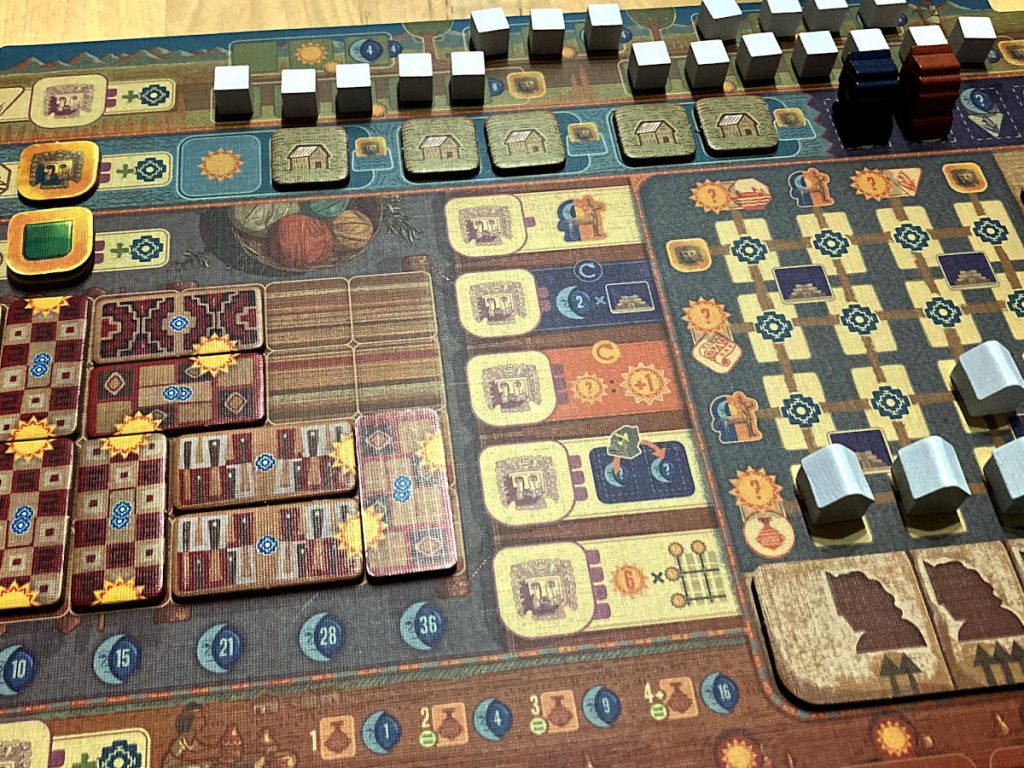
Tambos, Time and Tension
What ties everything together is the Tambo grid. To take an action, you place one of your workers in a row or column of your Tambo grid. The colour of your workers relates to the Ayars, which are moved forward along their paths accordingly. You then take a Tambo from the grid and place it on an action space behind the relevant Ayar. Depending on how many Tambos have already been removed from the row or column, your action will be more powerful.
That creates another puzzle. You want to clear your Tambo grid to get more powerful actions, but because the grid also triggers bonuses and scoring events, you need to plan ahead and time things correctly if you want to win.
Additionally, given that your workers are linked to the Ayar, and given that one Ayar retires at the end of each round, you will have one less worker in the next round. That speeds up the game. It also increases the tension, because as you start to figure out what you need to do to bring your Sun and Moon points in line, there will only be a few workers left before the game ends. That’s what I was referring to earlier.
Luckily, the game has a mechanism that allows you to boost one, or even both, scores. During the game, you can collect llama tokens that you spend at the end of the game to adjust your Sun and/or Moon tally.
Even so, you do need to think strategically from the start. You need to figure out which Ayar is most likely to retire at the end of the round, so you can adapt accordingly. If you don’t think on your feet, the game will be over and you will have been left behind.
Pastel Peaks and Wooden Wonders
It really helps that Ayar: Children of the Sun is so beautiful. The pastel palette used by Ian O’Toole makes it easy to see iconography, the tracks and the different activity areas.
The game is also very sculptural. The way the male and female Ayar figures fit perfectly together when they retire is gorgeously designed. It’s as if they greet each other and acknowledge their demise with a final kiss. It’s a tiny detail, but it turns a simple game mechanism into a poignant moment.
In fact, the component quality is high throughout. The cardboard tiles are thick, the wooden components well-made, and the boards are very sturdy. The insert also deserves praise, be it with one lament. It’s one of those inserts that gives a quiet sense of satisfaction with everything in its rightful place, except maybe for the llamas, which don’t seem to have anywhere to go.
Now, I do have to raise the biggest issue I have with Ayar: Children of the Sun: the setup. There are so many components. Every player has to place 16 Tambos and 22 cubes. That’s not all. The stacks of textile and pottery tiles are very fiddly to set up. The stacks are quite tall and can easily topple over. It feels unnecessary. The tiles could easily be drawn from the insert, which would make setup a little bit quicker and much less frustrating.
Another thing to consider is that the main game board is very large. While at two players, you can set it up so everything is in easy reach of everyone, but with three and especially four players, some of you may struggle to get to everything or even be able to see everything easily. Maybe it’s unavoidable, but it can cause a bit of a problem.
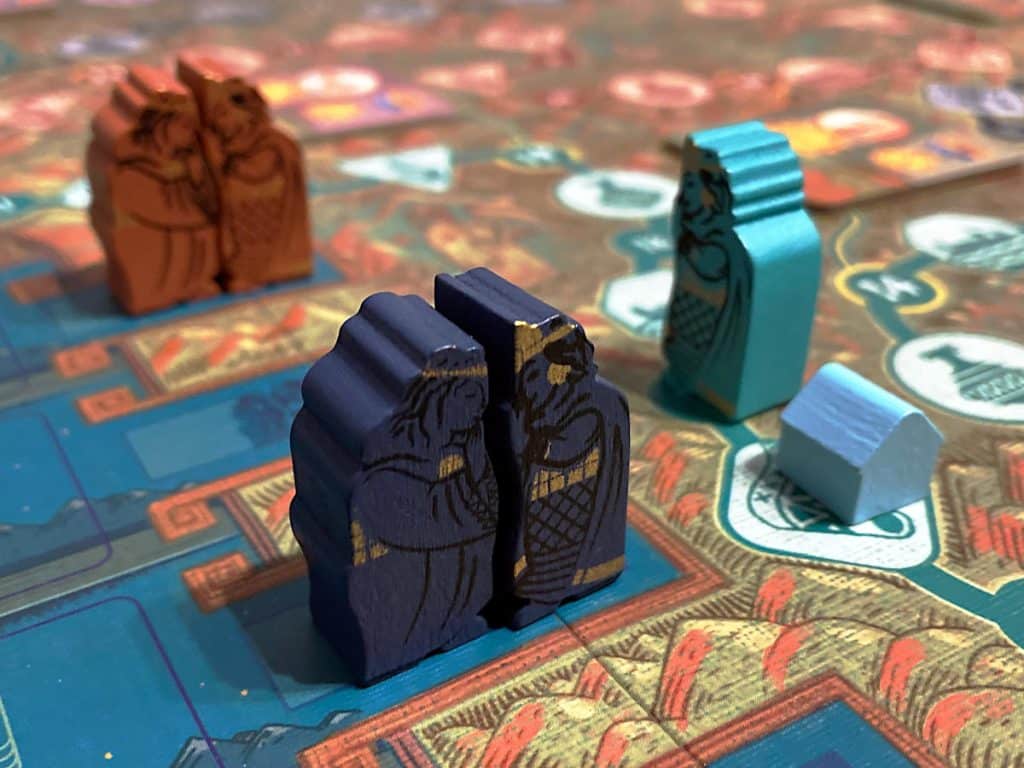
Interaction and Repetition
There is very little direct player interaction in Ayar: Children of the Sun. Sure, you can take a pottery tile before someone else gets to it. You can rush across the lake faster than a rival. Even terrace farming is a contest. However, you can’t really stop someone from doing what they want to do. The game is more of a solitary puzzle than a direct contest, more quiet optimisation than tactical back and forth. As a result, players tend to focus on their own tableaus, with other players’ actions being something that happens somewhere in their peripheral vision rather than being full in their face.
Saying that, the more players are at the table, the tighter the experience becomes. At two players, the puzzle feels wide open and very relaxed. At three or four players, the pressure does increase, with more competition for tiles, more focus on the race elements, and some more tactical timing required. However, a higher player count doesn’t change Ayar: Children of the Sun from a multiplayer solitaire experience to one of direct competition.
Of course, multiplayer solitaire games aren’t bad in themselves. I know people who love them. Yet, the more you play Ayar: Children of the Sun, the sooner it will feel repetitive. After you have tried a few different strategies, you will eventually notice that you do the same things every game, over and over again. The challenge doesn’t change, even if the people you play with change. The lack of direct player interaction means that you can follow similar strategies repeatedly, gently adjusting rather than having to dramatically change your approach with every game. While the puzzles always remain interesting, the freshness of the game eventually fades.
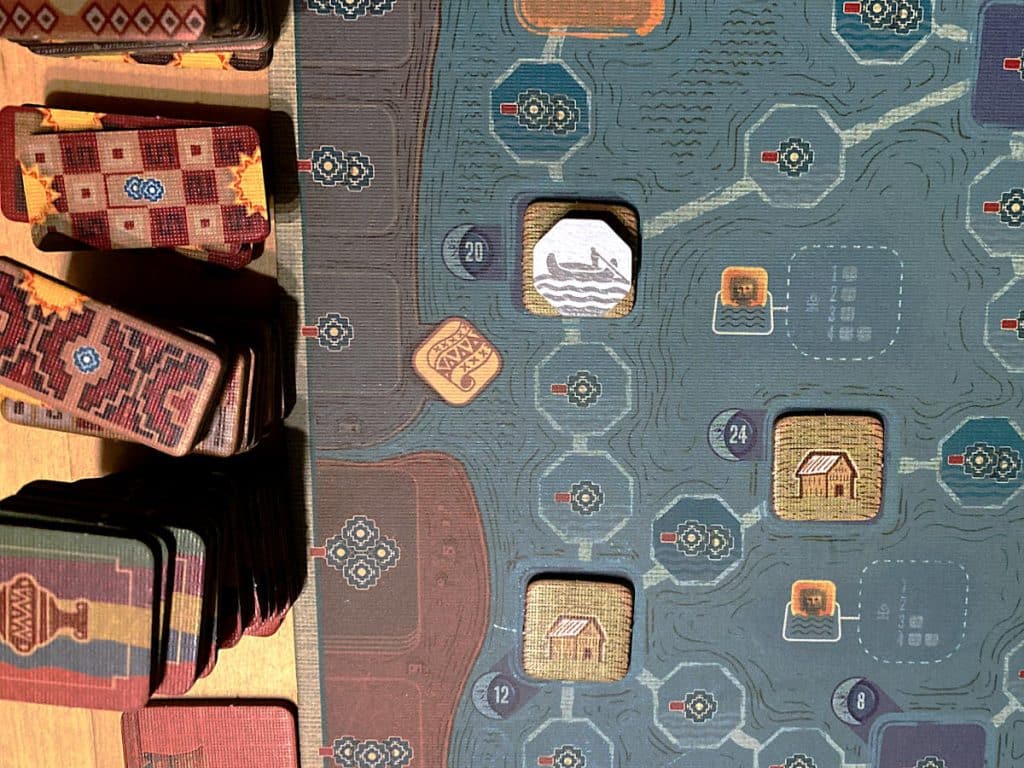
Reaching Tawantinsuyu
It is at this point that I can’t help myself but compare Ayar: Children of the Sun with The Druids of Edora. They both offer a similar point salad experience, but Druids is quicker to set up and offers more direct player interaction. It’s also different every time you play, because of the randomness during setup.
Ayar: Children of the Sun hides its enjoyment inside a giant reed field of mechanisms: pattern matching, set collection, the puzzle of the Tambo grid, racing across the lake and competing in terrace farming. The game also puts up a daunting wall of fiddly setup. Yes, it’s fun, once it’s on the table and you’ve got used to the rules. There is definitely something undeniably enticing about Ayar: Children of the Sun, because of its evocative setting, the soothing colours, the rewarding puzzles, and the gorgeous components, but Druids is just the easier choice for me.
Those who love thoughtful puzzles with a strong sense of setting, a generous helping of tactile satisfaction and the draw of the mystical history of the Incas will adore Ayar: Children of the Sun, especially at higher player counts. For me though, and those of you seeking more immediacy and more direct player interaction, the journey north from Tiwanaku is probably a touch longer and more arduous than we will want to endure.
This blog is free for everyone, but if you'd like to support it, here are some options.
Useful Links
- Ayar: Children of the Sun: https://www.
ospreypublishing. com/ uk/ ayar-children-of-the-sun-9781472860071/ - Rulebook: https://www.
ospreypublishing. com/ media/ fcyh2h5j/ ayar-rulebook. pdf - Osprey Games: https://www.
ospreypublishing. com/ uk/ - BGG listing: https://boardgamegeek.
com/ boardgame/ 429438/ ayar-children-of-the-sun - UK Games Expo 2025 review: https://tabletopgamesblog.
com/ 2025/ 06/ 07/ uk-games-expo-2025-saturday-review/ - The Druids of Edora review: https://tabletopgamesblog.
com/ 2025/ 11/ 15/ the-druids-of-edora-saturday-review/
Videos
Transparency Facts
- I was given a free review copy of this game by the publisher.
- At the time of writing, I have not received financial support from the publisher or anyone working on their behalf.
Audio Version
Intro Music: Bomber (Sting) by Riot (https://www.
Music: Beauty Of The Earth 3 – Grasslands, produced by Sascha Ende
Link: https://ende.
Music: Binaural Sleep Vol. 5, produced by Sascha Ende
Link: https://ende.
Playlist
These are the songs I listened to while I was writing this review:




